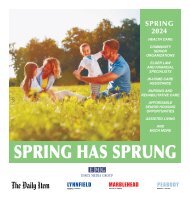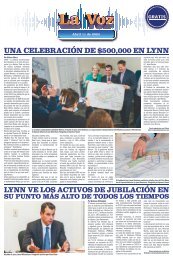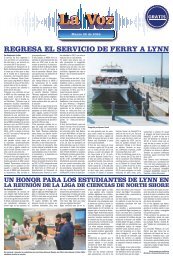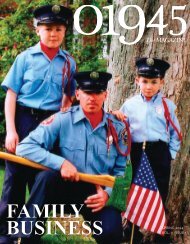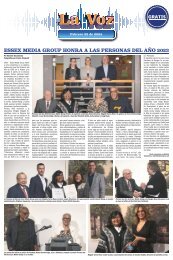Create successful ePaper yourself
Turn your PDF publications into a flip-book with our unique Google optimized e-Paper software.
32 | 01940
Where the wild
things grow
BY DANIEL KANE
Sometimes it's hard to realize what's in your
own backyard.
Just off the beaten path away from the town's
landmarks and oasis of stores and restaurants at
MarketStreet and a short distance away from
local golf courses, schools and neighborhoods, is
an untamed natural habitat that, in many ways,
defines Lynnfield.
Reedy Meadow is the largest freshwater
cattail marsh in Massachusetts, serving as an
epicenter where several local waterways drain.
It is also one of the most historicallysignificant
areas in town.
The marsh was declared a National Natural
Landmark in 1972 by the National Park Service.
That makes it one of only 11 similar sites
in Massachusetts and the only one in Essex
County.
The Saugus River along with Robinsons
Brook, Bates Brook, and Beaver Dam Brook
flow into what can almost be described as a
giant 1,200-acre sponge that prevents flooding
and becomes a great place for plants and animals
to thrive.
Reedy Meadow is mostly made up of cattail,
which has brown tips that actually resemble
a dark-colored sponge themselves. Other
vegetation includes Common Reed, another
wetland grass, and Purple Loosestrife, which
have purple flowers.
There are also areas of scrub, especially
Buttonbush, swamp, an area of seasonally
flooded canary-grass meadow, some areas of
Tussock-sedge meadow, bordering areas of
wooded Red Maple swamp and some wooded
islands and peninsulas dominated by oak-conifer
forest.
That diverse expanse of land is obviously
home to an even wider range of wildlife. Even
with careful efforts to protect Reedy, some
of the rarest animals found in the marsh are
increasingly harder to spot, including several
bird species classified as endangered.
Those species have gone from "threatened" to
endangered over the decades.
Reedy Meadow was designated as a "Priority
Wildlife Habitat" in 2017 by the Massachusetts
Natural Heritage and Endangered Species
Program.
Marsh birds still nest in the cattails, but
human disruption, along with several other
factors have hurt nesting in recent years.
Visiting Reedy is easier said than done.
There are a pair of great views of the area at
both Reedy Meadow and King Rail Reserve golf
courses.
Many local trails have become overgrown
and wild, and the best access may be available by
traveling along the old railroad bed at Summer
Street by St. Paul’s Church — just blocks from
plenty of local backyards.
PHOTOS: SPENSER HASAK




